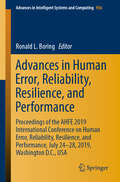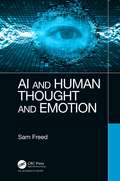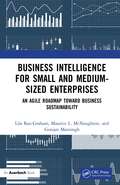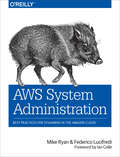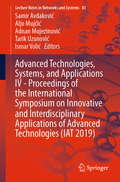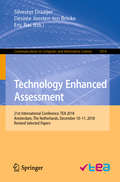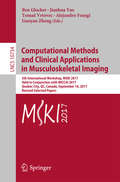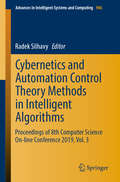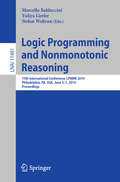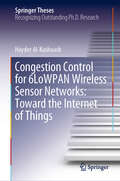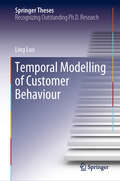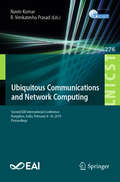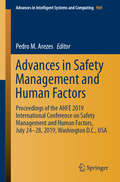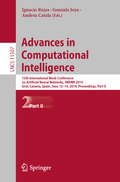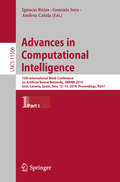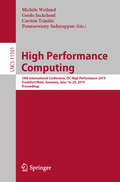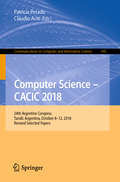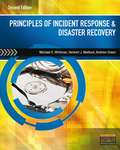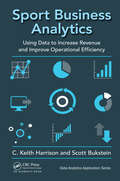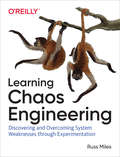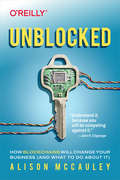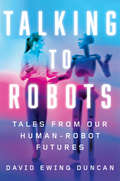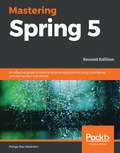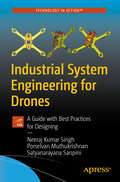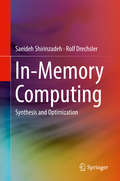- Table View
- List View
Advances in Human Error, Reliability, Resilience, and Performance: Proceedings of the AHFE 2019 International Conference on Human Error, Reliability, Resilience, and Performance, July 24-28, 2019, Washington D.C., USA (Advances in Intelligent Systems and Computing #956)
by Ronald L. BoringThis book brings together studies broadly addressing human error from different disciplines and perspectives. It discusses topics such as human performance; human variability and reliability analysis; medical, driver and pilot error, as well as automation error; root cause analyses; and the cognitive modeling of human error. In addition, it highlights cutting-edge applications in safety management, defense, security, transportation, process controls, and medicine, as well as more traditional fields of application. Based on the AHFE 2019 International Conference on Human Error, Reliability, Resilience, and Performance, held on July 24-28, 2019, Washington D.C., USA, the book includes experimental papers, original reviews, and reports on case studies, as well as meta-analyses, technical guidelines, best practice and methodological papers. It offers a timely reference guide for researchers and practitioners dealing with human error in a diverse range of fields.
AI and Human Thought and Emotion
by Sam FreedThe field of artificial intelligence (AI) has grown dramatically in recent decades from niche expert systems to the current myriad of deep machine learning applications that include personal assistants, natural-language interfaces, and medical, financial, and traffic management systems. This boom in AI engineering masks the fact that all current AI systems are based on two fundamental ideas: mathematics (logic and statistics, from the 19th century), and a grossly simplified understanding of biology (mainly neurons, as understood in 1943). This book explores other fundamental ideas that have the potential to make AI more anthropomorphic. Most books on AI are technical and do not consider the humanities. Most books in the humanities treat technology in a similar manner. AI and Human Thought and Emotion, however is about AI, how academics, researchers, scientists, and practitioners came to think about AI the way they do, and how they can think about it afresh with a humanities-based perspective. The book walks a middle line to share insights between the humanities and technology. It starts with philosophy and the history of ideas and goes all the way to usable algorithms. Central to this work are the concepts of introspection, which is how consciousness is viewed, and consciousness, which is accessible to humans as they reflect on their own experience. The main argument of this book is that AI based on introspection and emotion can produce more human-like AI. To discover the connections among emotion, introspection, and AI, the book travels far from technology into the humanities and then returns with concrete examples of new algorithms. At times philosophical, historical, and technical, this exploration of human emotion and thinking poses questions and provides answers about the future of AI.
Business Intelligence for Small and Medium-Sized Enterprises: An Agile Roadmap toward Business Sustainability
by Lila Rao-Graham Maurice L. McNaughton Gunjan MansinghBusiness intelligence (BI) has evolved over several years as organizations have extended their online transaction processing (OLTP) capabilities and applications to support their routine operations. With online analytical processing (OLAP), organizations have also established the capability to extract internal and external data from a variety of sources to specifically obtain intelligence about non-routine and often less-structured arrangements. BI therefore refers to applications and technologies that are used to gather, provide access to, and analyze data and information about the operations of an organization. It has the capability of providing comprehensive insight into the more volatile factors affecting the business and its operations, thereby facilitating enhanced decision-making quality and contributing to the creation of business value. Larger and more sophisticated organizations have long been exploiting these capabilities. Business Intelligence for Small and Medium-Sized Enterprises (SMEs) guides SMEs in replicating this experience to provide an agile roadmap toward business sustainability. The book points out that successful BI implementations have generated significant increases in revenue and cost savings, however, the failure rates are also very high. More importantly, it emphasizes that a full range of BI capabilities is not the exclusive purview of large organizations. It shows how SMEs make extensive use of BI techniques to develop the kind of agility endowing them with the organizational capability to sense and respond to opportunities and threats in an increasingly dynamic business environment. It points to the way to a market environment in which smaller organizations could have a larger role. In particular, the book explains that by establishing the agility to leverage internal and external data and information assets, SMEs can enhance their competitiveness by having a comprehensive understanding of the key to an agile roadmap for business sustainability.
AWS System Administration: Best Practices for Sysadmins in the Amazon Cloud
by Mike Ryan Federico LucifrediWith platforms designed for rapid adaptation and failure recovery such as Amazon Web Services, cloud computing is more like programming than traditional system administration. Tools for automatic scaling and instance replacement allow even small DevOps teams to manage massively scalable application infrastructures—if team members drop their old views of development and operations and start mastering automation.This comprehensive guide shows developers and system administrators how to configure and manage AWS services including EC2, CloudFormation, Elastic Load Balancing, S3, and Route 53. Sysadms will learn will learn to automate their favorite tools and processes; developers will pick up enough ops knowledge to build a robust and resilient AWS application infrastructure.Launch instances with EC2 or CloudFormationSecurely deploy and manage your applications with AWS toolsLearn to automate AWS configuration management with Python and PuppetDeploy applications with Auto Scaling and Elastic Load BalancingExplore approaches for deploying application and infrastructure updatesSave time on development and operations with reusable componentsLearn strategies for managing log files in AWS environmentsConfigure a cloud-aware DNS service with Route 53Use AWS CloudWatch to monitor your infrastructure and applications
Advanced Technologies, Systems, and Applications IV -Proceedings of the International Symposium on Innovative and Interdisciplinary Applications of Advanced Technologies (Lecture Notes in Networks and Systems #83)
by Samir Avdaković Aljo Mujčić Adnan Mujezinović Tarik Uzunović Ismar VolićThis book presents the scientific outcomes of the conference 11th Days of Bosnian-Herzegovinian American Academy of Arts and Sciences, held in Sarajevo, Bosnia and Herzegovina, June 20–23, 2019. Including innovative applications of advanced technologies, it offers a uniquely comprehensive, multidisciplinary and interdisciplinary overview of the latest developments in a broad range of technologies and methodologies, viewed through the prism of computing, networking, information technology, robotics, complex systems, communications, energy, mechanical engineering, economics and medicine, among others.
Technology Enhanced Assessment: 21st International Conference, TEA 2018, Amsterdam, The Netherlands, December 10–11, 2018, Revised Selected Papers (Communications in Computer and Information Science #1014)
by Silvester Draaijer Desirée Joosten-ten Brinke Eric RasThis book constitutes the proceedings of the 21st International Conference on Technology Enhanced Assessment, TEA 2018, held in Amsterdam, The Netherlands, in December 2018. The 14 papers presented were carefully selected from 34 submissions. They are centered around topics like e-learning, computer-assisted instruction, interactive learning environments, collaborative learning, computing education, student assessment.
Computational Methods and Clinical Applications in Musculoskeletal Imaging: 5th International Workshop, MSKI 2017, Held in Conjunction with MICCAI 2017, Quebec City, QC, Canada, September 10, 2017, Revised Selected Papers (Lecture Notes in Computer Science #10734)
by Tomaž Vrtovec Jianhua Yao Ben Glocker Alejandro Frangi Guoyan ZhengThis book constitutes the refereed proceedings of the 5th International Workshop and Challenge on Computational Methods and Clinical Applications for Musculoskeletal Imaging, MSKI 2017, held in conjunction with MICCAI 2017, in Quebec City, QC, Canada, in September 2017. The 13 workshop papers were carefully reviewed and selected for inclusion in this volume. Topics of interest include all major aspects of musculoskeletal imaging, for example: clinical applications of musculoskeletal computational imaging; computer-aided detection and diagnosis of conditions of the bones, muscles and joints; image-guided musculoskeletal surgery and interventions; image-based assessment and monitoring of surgical and pharmacological treatment; segmentation, registration, detection, localization and visualization of the musculoskeletal anatomy; statistical and geometrical modeling of the musculoskeletal shape and appearance; image-based microstructural characterization of musculoskeletal tissue; novel techniques for musculoskeletal imaging.
Cybernetics and Automation Control Theory Methods in Intelligent Algorithms: Proceedings of 8th Computer Science On-line Conference 2019, Vol. 3 (Advances in Intelligent Systems and Computing #986)
by Radek SilhavyThis book discusses novel intelligent-system algorithms and methods in cybernetics, presenting new approaches in the field of cybernetics and automation control theory. It constitutes the proceedings of the Cybernetics and Automation Control Theory Methods in Intelligent Algorithms Section of the 8th Computer Science On-line Conference 2019 (CSOC 2019), held on-line in April 2019.
Logic Programming and Nonmonotonic Reasoning: 15th International Conference, LPNMR 2019, Philadelphia, PA, USA, June 3-7, 2019, Proceedings (Lecture Notes in Computer Science #11481)
by Marcello Balduccini Yuliya Lierler Stefan WoltranThis book constitutes the refereed proceedings of the 15th International Conference on Logic Programming and Nonmonotonic Reasoning, LPNMR 2019, held in Philadelphia, PA, USA, in June 2019.The 22 full papers and 3 short papers presented in this volume were carefully reviewed and selected from a total of 39 submissions. The papers were organized in topical sections named: applications; argumentation; foundations and complexity; knowledge representation and reasoning; and systems.
Congestion Control for 6LoWPAN Wireless Sensor Networks: Toward the Internet of Things (Springer Theses)
by Hayder Al-KashoashThe Internet of Things (IoT) is the next big challenge for the research community. The IPv6 over low power wireless personal area network (6LoWPAN) protocol stack is considered a key part of the IoT. In 6LoWPAN networks, heavy network traffic causes congestion which significantly degrades network performance and impacts on quality of service aspects. This book presents a concrete, solid and logically ordered work on congestion control for 6LoWPAN networks as a step toward successful implementation of the IoT and supporting the IoT application requirements. The book addresses the congestion control issue in 6LoWPAN networks and presents a comprehensive literature review on congestion control for WSNs and 6LoWPAN networks. An extensive congestion analysis and assessment for 6LoWPAN networks is explored through analytical modelling, simulations and real experiments. A number of congestion control mechanisms and algorithms are proposed to mitigate and solve the congestion problem in 6LoWPAN networks by using and utilizing the non-cooperative game theory, multi-attribute decision making and network utility maximization framework. The proposed algorithms are aware of node priorities and application priorities to support the IoT application requirements and improve network performance in terms of throughput, end-to-end delay, energy consumption, number of lost packets and weighted fairness index.
Temporal Modelling of Customer Behaviour (Springer Theses)
by Ling LuoThis book describes advanced machine learning models – such as temporal collaborative filtering, stochastic models and Bayesian nonparametrics – for analysing customer behaviour. It shows how they are used to track changes in customer behaviour, monitor the evolution of customer groups, and detect various factors, such as seasonal effects and preference drifts, that may influence customers’ purchasing behaviour. In addition, the book presents four case studies conducted with data from a supermarket health program in which the customers were segmented and the impact of promotional activities on different segments was evaluated. The outcomes confirm that the models developed here can be used to effectively analyse dynamic behaviour and increase customer engagement. Importantly, the methods introduced here can also be used to analyse other types of behavioural data such as activities on social networks, and educational systems.
Ubiquitous Communications and Network Computing: Second EAI International Conference, Bangalore, India, February 8–10, 2019, Proceedings (Lecture Notes of the Institute for Computer Sciences, Social Informatics and Telecommunications Engineering #276)
by Navin Kumar R. Venkatesha PrasadThis book constitutes the refereed proceedings of the Second International Conference on Ubiquitous Communications and Network Computing, UBICNET 2019, held in Bangalore, India, in February 2019. The 19 full papers were selected from 52 submissions and are basically arranged in different sessions on security and energy efficient computing, software defined networks, cloud computing and internet of things applications, and the advanced communication systems and networks.
Advances in Safety Management and Human Factors: Proceedings of the AHFE 2019 International Conference on Safety Management and Human Factors, July 24-28, 2019, Washington D.C., USA (Advances in Intelligent Systems and Computing #969)
by Pedro M. ArezesThis book discusses the latest findings on ensuring employees’ safety, health, and welfare at work. It combines a range of disciplines – e.g. work physiology, health informatics, safety engineering, workplace design, injury prevention, and occupational psychology – and presents new strategies for safety management, including accident prevention methods such as performance testing and participatory ergonomics. The book, which is based on the AHFE 2019 International Conference on Safety Management and Human Factors, held on July 24-28, 2019, Washington D.C., USA, provides readers, including decision makers, professional ergonomists and program managers in government and public authorities, with a timely snapshot of the state of the art in the field of safety, health, and welfare management. It also addresses agencies such as the Occupational Safety and Health Administration (OSHA) and the National Institute for Occupational Safety and Health (NIOSH), as well as other professionals dealing with occupational safety and health.
Advances in Computational Intelligence: 15th International Work-Conference on Artificial Neural Networks, IWANN 2019, Gran Canaria, Spain, June 12-14, 2019, Proceedings, Part II (Lecture Notes in Computer Science #11507)
by Ignacio Rojas Gonzalo Joya Andreu CatalaThis two-volume set LNCS 10305 and LNCS 10306 constitutes the refereed proceedings of the 15th International Work-Conference on Artificial Neural Networks, IWANN 2019, held at Gran Canaria, Spain, in June 2019.The 150 revised full papers presented in this two-volume set were carefully reviewed and selected from 210 submissions. The papers are organized in topical sections on machine learning in weather observation and forecasting; computational intelligence methods for time series; human activity recognition; new and future tendencies in brain-computer interface systems; random-weights neural networks; pattern recognition; deep learning and natural language processing; software testing and intelligent systems; data-driven intelligent transportation systems; deep learning models in healthcare and biomedicine; deep learning beyond convolution; artificial neural network for biomedical image processing; machine learning in vision and robotics; system identification, process control, and manufacturing; image and signal processing; soft computing; mathematics for neural networks; internet modeling, communication and networking; expert systems; evolutionary and genetic algorithms; advances in computational intelligence; computational biology and bioinformatics.
Advances in Computational Intelligence: 15th International Work-Conference on Artificial Neural Networks, IWANN 2019, Gran Canaria, Spain, June 12-14, 2019, Proceedings, Part I (Lecture Notes in Computer Science #11506)
by Ignacio Rojas Gonzalo Joya Andreu CatalaThis two-volume set LNCS 10305 and LNCS 10306 constitutes the refereed proceedings of the 15th International Work-Conference on Artificial Neural Networks, IWANN 2019, held at Gran Canaria, Spain, in June 2019.The 150 revised full papers presented in this two-volume set were carefully reviewed and selected from 210 submissions. The papers are organized in topical sections on machine learning in weather observation and forecasting; computational intelligence methods for time series; human activity recognition; new and future tendencies in brain-computer interface systems; random-weights neural networks; pattern recognition; deep learning and natural language processing; software testing and intelligent systems; data-driven intelligent transportation systems; deep learning models in healthcare and biomedicine; deep learning beyond convolution; artificial neural network for biomedical image processing; machine learning in vision and robotics; system identification, process control, and manufacturing; image and signal processing; soft computing; mathematics for neural networks; internet modeling, communication and networking; expert systems; evolutionary and genetic algorithms; advances in computational intelligence; computational biology and bioinformatics.
High Performance Computing: 34th International Conference, ISC High Performance 2019, Frankfurt/Main, Germany, June 16–20, 2019, Proceedings (Lecture Notes in Computer Science #11501)
by Michèle Weiland Guido Juckeland Carsten Trinitis Ponnuswamy SadayappanThis book constitutes the refereed proceedings of the 34th International Conference on High Performance Computing, ISC High Performance 2019, held in Frankfurt/Main, Germany, in June 2019.The 17 revised full papers presented were carefully reviewed and selected from 70 submissions. The papers cover a broad range of topics such as next-generation high performance components; exascale systems; extreme-scale applications; HPC and advanced environmental engineering projects; parallel ray tracing - visualization at its best; blockchain technology and cryptocurrency; parallel processing in life science; quantum computers/computing; what's new with cloud computing for HPC; parallel programming models for extreme-scale computing; workflow management; machine learning and big data analytics; and deep learning and HPC.
Computer Science – CACIC 2018: 24th Argentine Congress, Tandil, Argentina, October 8–12, 2018, Revised Selected Papers (Communications in Computer and Information Science #995)
by Patricia Pesado Claudio AcitiThis book constitutes revised selected papers from the 24th Argentine Congress on Computer Science, CACIC 2018, held in Tandil, Argentina, in October 2018. The 26 papers presented in this volume were carefully reviewed and selected from a total of 155 submissions. They were organized in topical sections named: Agents and Systems; Distributed and Parallel Processing; Technology Applied to Education; Graphic Computation, Images and Visualization; Software Engineering; Databases and Data Mining; Hardware Architectures, Networks, and Operating Systems; Innovation in Software Systems; Signal Processing and Real-Time Systems; Computer Security; Innovation in Computer Science Education; and Digital Governance and Smart Cities.
Principles Of Incident Response And Disaster Recovery
by Michael Whitman Herbert Mattord Andrew GreenPrinciples Of Incident Response And Disaster Recovery, 2nd Edition presents methods to identify vulnerabilities within computer networks and the countermeasures that mitigate risks and damage. From market-leading content on contingency planning, to effective techniques that minimize downtime in an emergency, to curbing losses after a breach, this text is the resource needed in case of a network intrusion.
Sport Business Analytics: Using Data to Increase Revenue and Improve Operational Efficiency (Data Analytics Applications)
by C. Harrison Scott BuksteinDeveloping and implementing a systematic analytics strategy can result in a sustainable competitive advantage within the sport business industry. This timely and relevant book provides practical strategies to collect data and then convert that data into meaningful, value-added information and actionable insights. Its primary objective is to help sport business organizations utilize data-driven decision-making to generate optimal revenue from such areas as ticket sales and corporate partnerships. To that end, the book includes in-depth case studies from such leading sports organizations as the Orlando Magic, Tampa Bay Buccaneers, Duke University, and the Aspire Group. The core purpose of sport business analytics is to convert raw data into information that enables sport business professionals to make strategic business decisions that result in improved company financial performance and a measurable and sustainable competitive advantage. Readers will learn about the role of big data and analytics in: Ticket pricing Season ticket member retention Fan engagement Sponsorship valuation Customer relationship management Digital marketing Market research Data visualization. This book examines changes in the ticketing marketplace and spotlights innovative ticketing strategies used in various sport organizations. It shows how to engage fans with social media and digital analytics, presents techniques to analyze engagement and marketing strategies, and explains how to utilize analytics to leverage fan engagement to enhance revenue for sport organizations. Filled with insightful case studies, this book benefits both sports business professionals and students. The concluding chapter on teaching sport analytics further enhances its value to academics.
Learning Chaos Engineering: Discovering and Overcoming System Weaknesses Through Experimentation
by Russ MilesMost companies work hard to avoid costly failures, but in complex systems a better approach is to embrace and learn from them. Through chaos engineering, you can proactively hunt for evidence of system weaknesses before they trigger a crisis. This practical book shows software developers and system administrators how to plan and run successful chaos engineering experiments.System weaknesses go beyond your infrastructure, platforms, and applications to include policies, practices, playbooks, and people. Author Russ Miles explains why, when, and how to test systems, processes, and team responses using simulated failures on Game Days. You’ll also learn how to work toward continuous chaos through automation with features you can share across your team and organization.Learn to think like a chaos engineerBuild a hypothesis backlog to determine what could go wrong in your systemDevelop your hypotheses into chaos engineering experiment Game DaysWrite, run, and learn from automated chaos experiments using the open source Chaos ToolkitTurn chaos experiments into tests to confirm that you’ve overcome the weaknesses you discoveredObserve and control your automated chaos experiments while they are running
Unblocked: How Blockchains Will Change Your Business (and What to Do About It)
by Alison McCauleyRemember the dawn of the internet or the advent of mobile computing and social media? Yet another digital revolution is now underway. Like its predecessors, blockchains are about to transform the way we live, work, and play, while disrupting entrenched industries and shattering conventional business models.This practical guide takes you past the hype to show you exactly what blockchains do and how they’re poised to change our world. Author Alison McCauley explains how blockchains provide an open, distributed ledger for recording transactions in a verifiable and permanent way. You will learn how this technology provides an abundance of opportunity for those who know how to leverage blockchains to address privacy risks, hacks, data misuse, and fraud.Unblocked explains:Why ignoring this technology exposes you to competitive disruptionWhat this new technology revolution embraces—no technical background requiredHow to prepare your organization to respond to the coming shift
Talking to Robots: Tales from Our Human-Robot Futures
by David Ewing DuncanAward-winning journalist David Ewing Duncan considers 24 visions of possible human-robot futures—Incredible scenarios from Teddy Bots to Warrior Bots, and Politician Bots to Sex Bots—Grounded in real technologies and possibilities and inspired by our imagination. What robot and AI systems are being built and imagined right now? What do they say about us, their creators? Will they usher in a fantastic new future, or destroy us? What do some of our greatest thinkers, from physicist Brian Greene and futurist Kevin Kelly to inventor Dean Kamen, geneticist George Church, and filmmaker Tiffany Shlain, anticipate about our human-robot future? For even as robots and A.I. intrigue us and make us anxious about the future, our fascination with robots has always been about more than the potential of the technology–it’s also about what robots tell us about being human.
Mastering Spring 5: An effective guide to build enterprise applications using Java Spring and Spring Boot framework, 2nd Edition
by Ranga Rao KaranamBuild scalable and flexible Rest APIs and microservices using the latest versions of Spring and Spring Boot Key Features Build Java-based enterprise applications using Spring 5.1 and Spring Boot 2.1 Create high performing, reusable, and scalable enterprise Java applications that are easy to test Gain powerful insights into advanced Spring and Spring Boot concepts to develop applications effectively Book Description Spring 5.1 is the latest release of the widely used Spring Framework. This book takes you through the evolution of building enterprise-ready applications with Spring and Spring Boot. Mastering Spring 5 starts with an overview of some of the important Spring Framework features relating to aspect-oriented programming, task scheduling, and scripting with the help of practical examples. You'll learn about the standard dependency injection specification for Java contexts and CDI and how the Spring Framework supports it. You'll gain an understanding of how application architectures have evolved from monoliths to microservices and be able to build your own microservices using Spring Boot. Complete with real-world examples, this book will help you gain powerful insights into Spring Boot 2.1 and learn how to develop cloud-native microservices with Spring Cloud. You'll even explore how to secure a REST API with Spring Security and get started with your first full stack application using React. Furthermore, you'll get to grips with Kotlin fundamentals and build a Kotlin project in Eclipse. By the end of this book, you'll be equipped with all the knowledge required to develop microservices and full stack applications with the Spring Framework. What you will learn Explore Spring Framework 5.1 features such as AOP, transaction management, task scheduling, and scripting Build REST APIs and microservices with Spring and Spring Boot Develop a secure REST API with Spring Security Build your first full stack React application Write efficient unit tests with Spring and Spring Boot Understand the advanced features that Spring Boot offers to develop and monitor applications Use Spring Cloud to deploy and manage applications on the Cloud Who this book is for This book is for experienced Java and enterprise Java developers and programmers who have a basic understanding of the Spring Framework.
Industrial System Engineering for Drones: A Guide with Best Practices for Designing
by Neeraj Kumar Singh Porselvan Muthukrishnan Satyanarayana SanpiniExplore a complex mechanical system where electronics and mechanical engineers work together as a cross-functional team. Using a working example, this book is a practical “how to” guide to designing a drone system.As system design becomes more and more complicated, systematic, and organized, there is an increasingly large gap in how system design happens in the industry versus what is taught in academia. While the system design basics and fundamentals mostly remain the same, the process, flow, considerations, and tools applied in industry are far different than that in academia. Designing Drone Systems takes you through the entire flow from system conception to design to production, bridging the knowledge gap between academia and the industry as you build your own drone systems.What You’ll LearnGain a high level understanding of drone systemsDesign a drone systems and elaborating the various aspects and considerations of designReview the principles of the industrial system design process/flow, and the guidelines for drone systemsLook at the challenges, limitations, best practices, and patterns of system designWho This Book Is ForPrimarily for beginning or aspiring system design experts, recent graduates, and system design engineers. Teachers, trainers, and system design mentors can also benefit from this content.
In-Memory Computing: Synthesis and Optimization
by Saeideh Shirinzadeh Rolf DrechslerThis book describes a comprehensive approach for synthesis and optimization of logic-in-memory computing hardware and architectures using memristive devices, which creates a firm foundation for practical applications. Readers will get familiar with a new generation of computer architectures that potentially can perform faster, as the necessity for communication between the processor and memory is surpassed. The discussion includes various synthesis methodologies and optimization algorithms targeting implementation cost metrics including latency and area overhead as well as the reliability issue caused by short memory lifetime.Presents a comprehensive synthesis flow for the emerging field of logic-in-memory computing;Describes automated compilation of programmable logic-in-memory computer architectures;Includes several effective optimization algorithm also applicable to classical logic synthesis;Investigates unbalanced write traffic in logic-in-memory architectures and describes wear leveling approaches to alleviate it.
